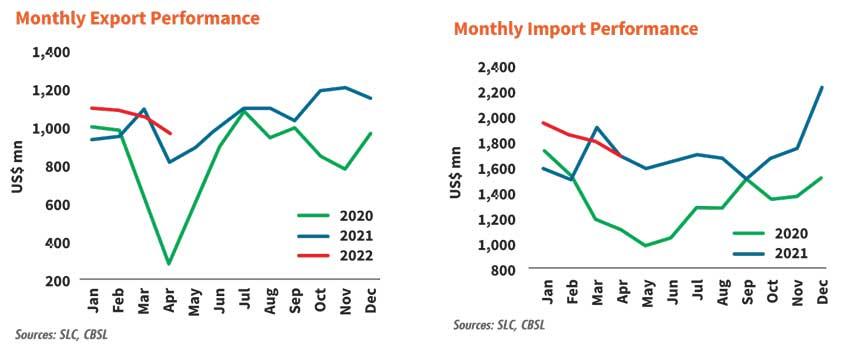15 Jun 2022 - {{hitsCtrl.values.hits}}

April external sector aptly demonstrated Sri Lanka’s over-reliance on imports for basic needs such as food, power and energy, and transport as expenditure on such categories stood out stubbornly high, making a strong case for the country to change its track if it is to emerge out of the current economic crisis, the worst in its post-independence history.
Sri Lanka’s imports bill slipped by marginal US$ 8 million to US$ 1,699 million in April from US$ 1,707 million a year ago as the country spent nearly 20 percent more for its food & beverage imports and 24 percent more for fuel as the prices of these commodities jumped while the country had to bring down more of these to make sure its people do not starve, factories run smoothly, power cuts are contained and people can commute.
Sri Lankan economy came to a grinding halt in early March when the country ran out of its dollar reserves after the then authorities lied to the public about the country’s ability to meet its daily imports while making good on the foreign obligations. Sri Lanka imports twice the amount that it exports, and the gap was met by the tourism and remittance inflows until the pandemic decimated the former and impaired the latter.
The country was also cut off from international capital markets in 2020 when its sovereign rating was downgraded after debt became increasingly unsustainable due to loss of State revenues and dollar inflows, caused by the 2019 tax cuts and exacerbated by the pandemic.
Sri Lanka in April imported goods worth US$ 1,699 million while it exported goods worth US$ 970 million, up 18.5 percent from a year ago, slimming the trade deficit to US$ 729 million from US$ 889 million a year earlier. While the rupee shed 80 percent of its value since March putting a damper on imports, the authorities took a slew of measures since early April to contain imports. They included hike in interest rates, restrictions on open accounts and consignment payments and imposing 100 percent margin on non-essential and non-urgent type goods to make more money available for food, medicine and fuel.
The measures appeared to have taken some hold as seen from the 43.4 percent decline to US$ 87.7 million in non-consumer goods such as home appliances, telecommunication devices and household and furniture items in April.
However, food and beverage imports rose by 19.8 percent to US$ 148.0 million due to milled rice imports, dairy products and vegetables as the disastrous organic fertiliser pivot last year pushed the country into a food shortage. Sri Lanka’s food inflation rose by nearly 60 percent according to the official consumer price index in May, while in reality prices have risen by many fold.
Meanwhile, Sri Lanka spent US$ 510.1 million on fuel imports, all of which were for refined oil and coal, an increase of 23.5 percent, as the demand for fuel rose due to prolonged shortages and the power crisis amid soaring global energy prices, particularly since Russia’s invasion of Ukraine in February.
Overall, intermediate goods imports rose by 11.3 percent to US$ 1,196.6 million in April over the same month last year as inputs for textiles rose by 23.1 percent to US$ 281.2 million.
Meanwhile, investment goods imports declined by 24.6 percent to US$ 266.3 million, reflecting that the contractionary policies of authorities were making a dent in construction related activities.
Sri Lankans will either have to cut down on their consumption drastically or rapidly increase their products to the global markets so that they could narrow the trade deficit to a sustainable level, as the world will no longer lend them any more money to continue their lavish spending on imports.
23 Nov 2024 23 Nov 2024
23 Nov 2024 23 Nov 2024
23 Nov 2024 23 Nov 2024
23 Nov 2024 23 Nov 2024
23 Nov 2024 23 Nov 2024